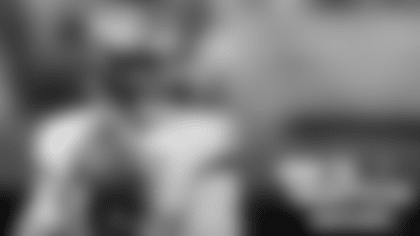Coaches don't always care for stats…but we love them! Each week, we're going to give you a closer look at three or four pieces of statistical analysis, hopefully in a way that is relevant to the Buccaneers' current state of affairs.
Let's get started.
**
1. Third Receivers the Key for Bucs' Pass Defense
We've leaned on Football Outsiders before here in Football Geekery, and alerted you to their particular brand of "Innovative Statistics, Intelligent Analysis" on many occasions. We've also admitted that it's mostly counterproductive for us to try to explain how some of their complicated statistical formulas are produced. That's certainly the case with "DVOA," or Defense-Adjusted Value Over Average, which is the signature stat on Football Outsiders. Click here if you want to read the methods behind DVOA.
For our purposes, you really only need to know two things to understand what significance we're putting on the latest numbers were borrowing from FO. 1) For a defense, the lower the number the better, and negative numbers are better than positive ones. 2) Once DVOA is calculated within any particular analysis, we can judge the Bucs' success by how they rate against the other 31 teams.
Knowing that, we can say this, thanks to a very intriguing chart on the site's team defense page. Under a more general DVOA chart, the site has posted another one that breaks down how each team's pass defense has fared, relative to the rest of the league, against five different categories of pass-catchers: #1 receivers, #2 receivers, other receivers, tight ends and running backs.
The numbers for the Buccaneers are seriously interesting. Keep in mind that negative numbers are good when you look at this chart of the DVOA for Tampa Bay's defense against those five categories:
|
Category |
DVOA |
NFL Rank |
1 receivers |
-13.0 |
11 |
2 receivers |
-5.8 |
15 |
|
Other receivers |
18.2 |
22 |
|
Tight ends |
2.7 |
17 |
|
Running backs |
-22.2 |
9 |
This table suggests that the Buccaneers have been above average against two types of pass-catchers: #1 receivers and running backs. They have been right around league average against two others: #2 receivers and tight ends. And they have struggled, strangely, against "other" receivers. It appears that when opponents go to three and four-receiver sets, it's the new pass-catchers on the field who have found a way to get open.
So how does that relate to Sunday's matchup against the Saints? Well, as has become obvious in recent years, everyone in the New Orleans passing attack is a potential problem. That said, Marques Colston and Devery Henderson are the two players listed as starting receivers, with Lance Moore and Courtney Roby behind them. Given Moore's proven big-play ability, he might be the most important Drew Brees target for the Buccaneers to stop this Sunday.
**
2. Going Deep
Drew Brees is coming to town this weekend, so you might be expecting an aerial assault at Raymond James Stadium on Sunday. The thing is, the Bucs' Sunday home has already been the site of some of the most extensive, and successful, downfield passing this season.
Josh Freeman and the Buccaneers have attempted 21 passes this season in which the ball has been thrown more than 20 yards downfield. That's actually right in the middle of the pack among NFL teams, just a little behind Brees and the Saints. Brees has tried 24 such passes. The highest team mark in this category is 32, by Baltimore, but there's a big group of 11 teams (a third of the league) clumped between 20 and 24 tries on that list.
Where it gets really good for the Buccaneers is in the rest of that chart, where completions, yards and touchdowns are included. If all NFL teams are ranked by passer rating on attempts where the ball is thrown more than 20 yards, Tampa Bay comes in third. Here are the top five:
|
Team |
Att |
Comp |
Yds |
TD |
Rating |
|
18 |
9 |
353 |
2 |
132.9 |
|
18 |
7 |
222 |
3 |
125.5 |
|
21 |
10 |
441 |
3 |
113.6 |
|
17 |
9 |
309 |
3 |
113.4 |
|
22 |
10 |
344 |
5 |
112.7 |
If it seems like the Bucs' raw numbers are actually better than the two teams above them, that's because interceptions aren't listed. Freeman has just one pick on those 21 downfield passes, but Miami and Green Bay have none, and that makes a pretty big difference in passer rating. By the way, New Orleans is 15th on the list, with a passer rating of 92.4.
**
3. Not Hurting Themselves
Head Coach Greg Schiano has said that he doesn't want the Buccaneers to be the least penalized team in the league. Aggressive play on defense is occasionally going to lead to plays that are deemed penalties, and Schiano doesn't want to sacrifice that aggression in the service of fewer flags.
There are some penalties, however, that no coach appreciates, ones that are the product of fundamental breakdowns. Procedural penalties on offense can be particularly infuriating to the men on the sideline.
As it turns out, though, the Bucs have been pretty good in that regard. Overall, Tampa Bay has been penalized 35 times for 277 yards this year (another four flags have been thrown but not accepted). The team is tied for 11th in the NFL in drawing penalties (with lower numbers being better, obviously), and is ninth in penalty yards.
Only 15 of those penalties have come on offense, however, costing the Bucs a total of 90 yards. Only three teams – Atlanta, Houston and Carolina – have a lower total of yards penalized while on offense. Also, only one of the four non-accepted penalties against Tampa Bay this year have been called on the offense.
There is hidden yardage here, of course. The chart lists how many yards were stepped off by the penalties assessed against each team, but it doesn't include the potential gain that was erased in each case. If an 80-yard touchdown is erased by an illegal formation penalty, it's easy to see that the flag cost that team a lot more than just five yards.
Still, the fewer flags thrown against the offense, the less likely that big plays will be wiped out. And, so far, the Bucs have done a good job of not shooting themselves in the foot when they have the ball.
























